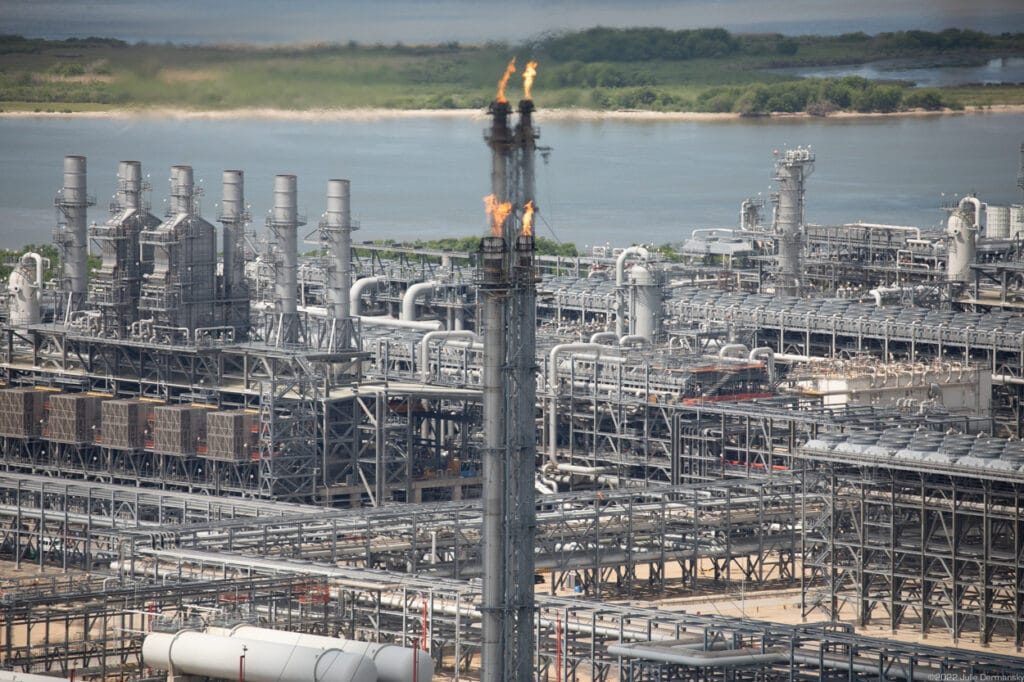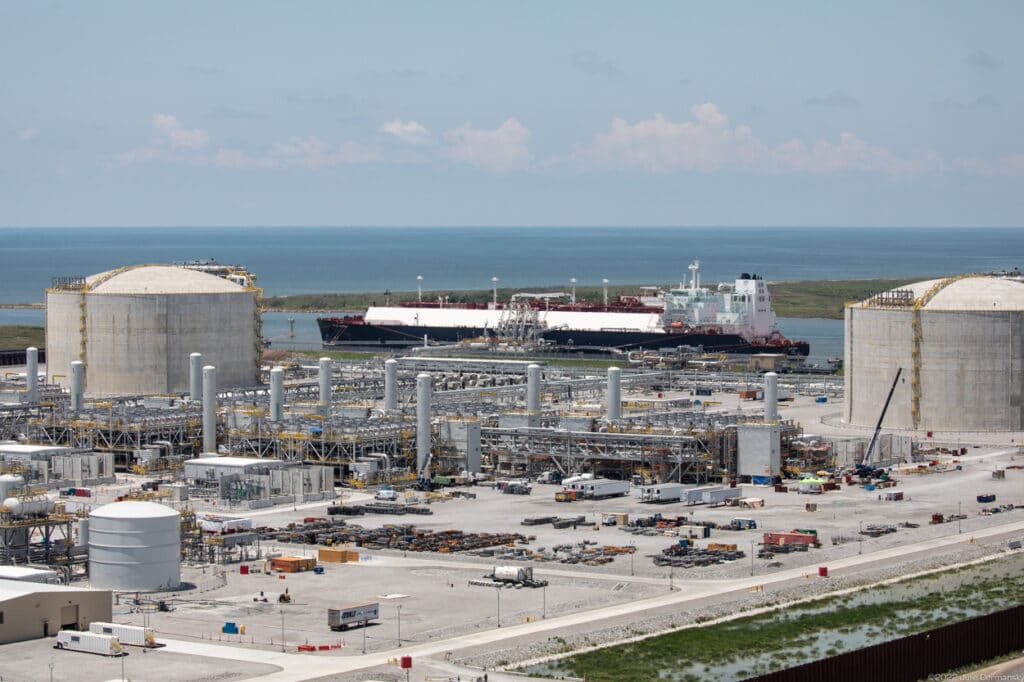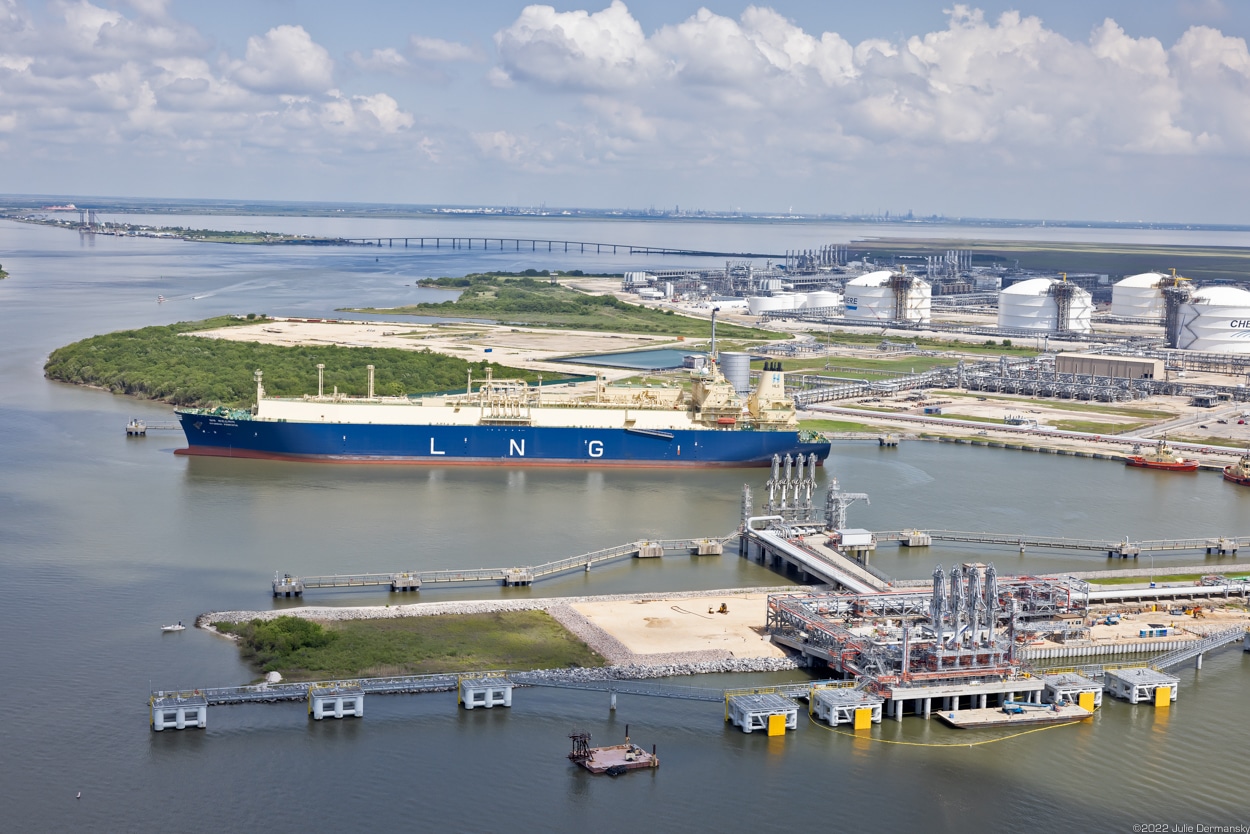In March, President Biden and European Commission President Ursula von der Leyen announced a joint task force with the goal of getting Europe off Russian gas and onto more of America’s fracked gas. Most Russian gas reaches Europe via pipeline, so getting U.S. gas to Europe will involve liquifying it and then shipping it across the Atlantic. And as shipments of liquified natural gas (LNG) from the United States increase, so too do the threats from an unwelcome intruder inherently part of America’s natural gas mix — radioactivity.
That’s because government figures indicate that much of the gas that will be shipped to Europe may come from the Marcellus and Utica, black shale formations in Ohio, West Virginia, and Pennsylvania. About 40 percent of natural gas produced in the United States comes from these formations, and, according to the U.S. Geological Survey, they have particularly high radioactivity levels.
Radioactivity is a problem at multiple points along the natural gas production chain, and oilfield workers and communities in the Marcellus and Utica have been beleaguered by an array of radiological concerns, from fires and spills at facilities processing radioactive oilfield waste to the discharge of this waste into drinking water supplies to high levels of radioactivity found on public roads near a high school football field.
But radioactivity is a problem not only in the production of natural gas; it also haunts the distribution chain. The radioactive gas radon, which is the second leading cause of lung cancer deaths in the United States, travels with the natural gas stream itself. Radon will break down into radioactive lead-210 and polonium-210, one of the most toxic substances on earth, which was famously used in 2006 by Russian assassins to kill the former spy Alexander Litvinenko. Academics and industry professionals alike are concerned about the potential for these radioactive isotopes to build up along the LNG distribution chain and harm workers and communities in the United States and Europe.

“It is entirely appropriate to be discussing the radioactivity levels in LNG,” says Mark Baskaran, a geologist at Wayne State University in Michigan and a world-renowned expert on radon who has studied oilfield radioactivity in the Marcellus and Utica.
However, it appears nobody in the United States or European governments behind the recent LNG deal is discussing radioactivity. Enesta Jones, a spokesperson for the Environmental Protection Agency (EPA), said, “EPA does not regulate radioactivity in oil and gas production, processing and transport systems.” Similarly, a representative from the Federal Energy Regulatory Commission (FERC) said the agency does not track oilfield radioactivity and “is also not involved in monitoring which countries, ports, or facilities receive US LNG.”
Detailed questions on the matter sent by DeSmog to the White House Office of Science and Technology Policy and to Matt Hill, who handles climate communications for the White House, have all gone unanswered.
“I can already tell you that no one in Europe is looking into LNG from a radioactivity point of view,” said Andy Gheorghiu, who is based in Germany and closely monitors LNG imports into Europe as co-founder of the Climate Alliance Against LNG.
Radioactive Natural Gas’s Journey to Europe
Liquified natural gas begins its journey as natural gas. Smaller pipelines typically take the gas from the wellhead to processing plants that remove impurities and separate out other hydrocarbons. From there, the natural gas is moved through larger transmission pipelines to LNG export terminals where it is cooled until it liquifies and reduces in volume. Once it has been liquified, it is loaded onto ships to be moved around the globe.
The whole process requires an extensive network of storage tanks, vessels, compressors, and pipes — each of which represents a place where radiation can build up and risk harming workers, communities, or the environment. And as the demand for LNG grows, so does the network of export terminals — and the potential for inadvertent radiological exposure in the United States and Europe.
The LNG export industry has been expanding for several years. In 2016, Houston-based Cheniere Energy opened the first LNG export terminal in the continental United States. Now there are eight facilities nationwide, with an additional 15 export terminals approved by FERC and seven more with applications pending. While many of these projects were inked before the war in Ukraine, the White House has promised a favorable regulatory environment for LNG projects to help wean Europe off of Russian gas.
“I can already tell you that no one in Europe is looking into LNG from a radioactivity point of view.”
– Andy Gheorghiu
Given this rapid expansion of LNG infrastructure, Baskaran feels more study of radioactivity in LNG and the general gas network is urgently needed. He and one of his graduate students, Bobby Manion, have performed a calculation to better understand the potential amounts of radiation and associated risks. While their analysis remains unpublished and has not been peer-reviewed, they believe the exercise is an important first step in trying to understand the scale of the problem.
Baskaran and Manion considered natural gas originating in the Marcellus formation, traveling through 350 miles of pipeline directly to an export terminal in Cove Point, Maryland, and then by ship to the LNG import terminal at Montoir de Bretagne on France’s Atlantic Coast. They assumed that this gas contains average levels of radon based on worldwide readings. Given the swiftness with which radon decays into radioactive isotopes, including lead-210 and polonium-210, and the tremendous load of the radioactive gas packed with the fuel onto the LNG ship, Baskaran and Manion found that the ship essentially becomes a massive lead-and-polonium-generating machine.
In the course of its transatlantic voyage, this ship’s load of natural gas would produce more than 134 million picocuries of lead-210 and nearly 17 million picocuries of polonium-210. (For context, a gram of soil anywhere on earth may contain between 1 and 5 picocuries of either isotope.) These radioactive isotopes would likely be dispersed throughout the ship, but the concern is that the tanks of the ship may overtime accumulate a radioactive sludge, and as the liquified natural gas is transformed back into natural gas on European shores this radioactivity could accumulate in certain places and pose dangers.
“These high levels of lead-210 and polonium-210 may result in contaminating the environment,” including any workers who clean radioactive sludge from the ships, containers, or facilities in Europe where the LNG is transformed back into natural gas, Baskaran explained.

Nazrin Babashova, an engineer living in Sweden, came to similar conclusions in her master’s thesis at Linnaeus University, which studied detecting radioactivity contamination in LNG systems. She predicted that significant amounts of lead-210 and polonium-210 could accumulate at an LNG export terminal inside pipe elbows, valves, joints, and any spot where the flow of gas suddenly expands, contracts, or changes direction. Her research showed that radioactivity would be expected to accumulate in the same types of places at LNG import facilities in Europe and elsewhere.
Babashova concludes her thesis by saying that to her knowledge, no formal study on the matter has been done and, as a result, it remains to be seen whether radioactivity “can pose a risk to the health of employees.”
But this is not just an academic issue. In September 2019, Alan McArthur, a leading industry expert on oilfield radioactivity, told a group of U.S. regulators at a symposium of the Conference of Radiation Control Program Directors that exceptional levels of radon, radioactive lead, and polonium are coursing through the natural gas pipeline system.
In a presentation, he warned of the dangers of inhaling or ingesting this radioactivity, advised that workers should wear respirators, and said that air monitoring should be required “on ALL” natural gas projects involving radioactivity. LNG is mentioned in McArthur’s presentation, although it does not detail how much radioactivity would accumulate in this part of the natural gas chain. McArthur did not reply to questions on the issue.
“Maintaining an Enabling Regulatory Environment”
Despite the known threats from radioactivity in natural gas and LNG, the hunger for LNG shows no sign of slowing. The U.S. Energy Information Administration expects the United States to eclipse Australia and Qatar to become the world’s largest exporter of LNG at some point this year. And the spate of new projects coming online in the next few years will further widen that gap.
“This is not a new relationship,” Gheorghiu said of the United States as a supplier of LNG to Europe. “It started back in July 2018, but has increased by 2,240 percent since then. So, this is definitely a deepening of the existing relationship, maybe this time with long-term contracts as icing on the cake for the US.”
“It is interesting to see that Russian LNG exports into the EU also grew exponentially in the same time,” he added. “[The] US and Russia have been main rivals for the EU LNG market.”
The recent U.S.-EU agreement calls for the United States and other partners to supply Europe with an additional 50 billion cubic meters of LNG a year “until at least 2030.” The European Union has pledged to swiften regulatory approvals for LNG import terminals and regasification units, while the United States has declared that supplying LNG to Europe is an “emergency energy security objective” and committed to “maintaining an enabling regulatory environment.”
“This is definitely a deepening of the existing relationship, maybe this time with long-term contracts as icing on the cake for the US.”
– Andy Gheorghiu
Neither the White House nor U.S. Department of Energy has responded to questions of just how this “enabling regulatory environment” would affect the industry’s ability to remove the radioactivity from LNG. Questions to European Union spokespeople specializing in climate change and also public health also have gone unanswered. Removing radioactivity from oil and gas infrastructure can be a difficult and dangerous task, and natural gas doesn’t have to be converted to LNG for the problem to develop.
“Radioactive films, coatings, or plating can form from natural-gas production or processing,” reads an industry paper on the topic published in 1993 in the Society of Petroleum Engineers’ Journal of Petroleum Technology. “Often invisible to the naked eye, these films contain radon and its decay products” and contamination “can be sufficiently severe that maintenance and other personnel may be exposed to hazardous concentrations.”
While the Society of Petroleum Engineers’ paper advises that “contaminated facilities and waste-material problems must be recognized and addressed,” it is difficult to determine just how thoroughly this advice has been followed across the United States in the decades since. There are no federal guidelines or regulations on the topic, and queries to industry groups, like the American Petroleum Institute, seeking information on worker radioactivity exposure best-practices have returned only general replies with no details.
Manion told DeSmog that Russian gas would likely have some degree of radioactivity contamination too, although estimating its potential harms to workers who interact with the fuel and consumers who use it appears to be impossible. “I’ve been reading papers on radioactive oilfield waste from all over the planet and I have not encountered any papers related to the Russian oil industry,” he said.
But research is no guarantee of action. In the United States, research into radioactivity in oil and gas goes back more than 50 years, yet no comprehensive nationwide rules exist to protect workers and communities from its potential harms.
Subscribe to our newsletter
Stay up to date with DeSmog news and alerts







